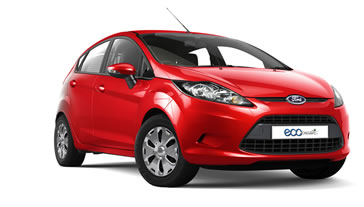Advanced Clean Diesel
In this section
- Advanced Clean Diesel
- HEVs
- BEVs
- PHEVs
- Renewable Biofueled Vehicles
- FCVs

Advanced Clean Diesel
Ford Fiesta ECOnetic
Modern diesels are 30 to 40 percent more fuel efficient than gasoline vehicles. Ford offers a range of advanced diesels in Europe under the ECOnetic label. In the U.S., Ford introduced a new diesel engine on the 2011 F-Series Super Duty® truck that has 20 percent better fuel economy than the outgoing model.
2007Begin migration to advanced technology |
2011Full implementation of known technology |
2020–2030Continue deploying advanced powertrains and alternative fuels and energy sources |
|---|---|---|
Advanced Clean Diesel |
||
Modern diesels offer some significant advantages over traditional gasoline engines. They consume 30 to 40 percent less fuel, and on a well-to-wheels basis they emit 15 to 30 percent less carbon dioxide (CO2).1 In addition, direct-injection diesel engines provide exceptional power and torque, resulting in better driving performance and towing capabilities.
In Europe, diesel-powered vehicles account for more than 50 percent of new vehicle sales and make up approximately 30 percent of the total vehicle fleet on the road. Ford continues to improve its strong lineup of fuel-efficient and clean diesel vehicles in Europe. For example, we continue to introduce ECOnetic versions of Ford models that deliver improved fuel economy and emissions. The ECOnetic lineup currently includes versions of the Ford Fiesta, Focus, Mondeo and Transit. Several of the ECOnetic models use diesel engines, which meet the stringent Euro 5 emissions standards and emit less than 100 g/km of CO2. For example, the new Focus ECOnetic has fuel economy of 3.4L/100km and emits just 89 g/km of CO2. This vehicle is powered by a 1.6L Duratorq TDCi that includes more efficient eight-hole fuel-injector nozzles, a more powerful engine-control unit and a water-cooled charge air cooler. In addition, parasitic losses have been cut through use of low-friction piston ring coatings, a variable flow oil pump and a more-efficient vacuum pump. After-treatment system improvements include a coated diesel particulate (soot) filter coupled with a lean NOx trap to enable Euro 5 emissions compliance.
In the North American medium-duty truck market, diesel engines account for more than 50 percent of sales. In response to this demand, Ford introduced an all-new 2011 F-Series Super Duty® truck with a state-of-the-art diesel engine, new six-speed transmission and urea/selective catalytic reduction after-treatment system. The 6.7L Power Stroke® V8 diesel is cleaner and has 20 percent better fuel economy, 14 percent more power and 23 percent more torque relative to the outgoing model. Ford has also announced plans for a diesel engine offering in the Transit van for North America.
These new diesel engines also meet the U.S. Environmental Protection Agency’s and the California Air Resources Board’s strict 2010 heavy-duty truck emission regulations, which require 80 percent lower NOx emissions than the 2007 regulations.
The Ford Super Duty uses a range of advanced technologies to meet the new regulations. For example, its 6.7L Power Stroke engine employs an innovative exhaust gas recirculation system with two independent cooling loops, which enable optimal combustion phasing for fuel economy while reducing NOx emissions from the engine into the after-treatment system. In addition, the after-treatment system has three key parts, including:
- a diesel oxidation catalyst that converts and oxidizes hydrocarbons into water and carbon dioxide;
- a selective catalytic reduction that uses an ammonia and water solution to convert the NOx in the exhaust stream into water and inert nitrogen; and
- a diesel particulate filter that traps any remaining soot and periodically burns it away when sensors detect that the trap is full.
Ford was an early industry leader in developing diesel engine after-treatment systems. We have been granted more than 100 patents for these advancements.
The 6.7L Power Stroke uses a high-precision, common-rail fuel-injection system featuring piezo-electric injectors. This system uses a stack of more than 300 wafer-thin ceramic platelets to control the fuel-injector nozzle, allowing it to operate faster than other electro-mechanical fuel injectors, decrease fuel consumption and reduce emissions.
The 2011 Super Duty is Ford’s first vehicle in North America that is B20 compatible, meaning it can run on fuel composed of 20 percent biodiesel and 80 percent ultra-low-sulfur diesel. Biodiesel is a renewable fuel made from soybean oil and other fats. We went through extensive testing to ensure that this new truck would meet performance and durability requirements when fueled with B20, including running durability cycles on multiple blends of diesel and biodiesel fuels to ensure the robustness of the system. In Europe, our vehicles are compatible with B7, and we are working with European fuel standards organizations to establish fuel-quality standards for biodiesel blends greater than B5. The use of biodiesel helps to reduce dependence on foreign oil and reduces lifecycle CO2 emissions. For more information on biofuels, please see the Renewable Biofueled Vehicles section.
- Figures based on J.L. Sullivan, R.E. Baker, B.A. Boyer, R.H. Hammerle, T.E. Kenney, L. Muniz, and T.J. Wallington, 2004, “CO2 Emission Benefit of Diesel (versus Gasoline) Powered Vehicles,” Environmental Science and Technology, 38: 3217-3223.
